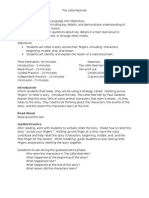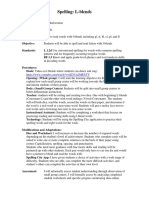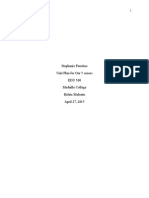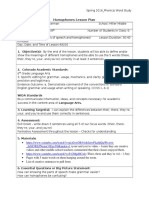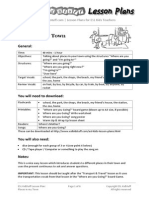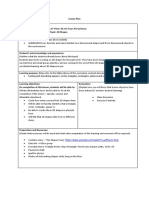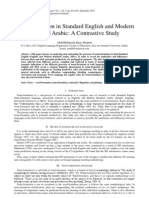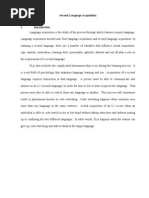Shopping Lesson Plan
Shopping Lesson Plan
Uploaded by
LaeliCopyright:
Available Formats
Shopping Lesson Plan
Shopping Lesson Plan
Uploaded by
LaeliCopyright
Available Formats
Share this document
Did you find this document useful?
Is this content inappropriate?
Copyright:
Available Formats
Shopping Lesson Plan
Shopping Lesson Plan
Uploaded by
LaeliCopyright:
Available Formats
www.eslkidstuff.
com | Lesson Plans for ESL Kids Teachers
Lesson:
Shopping and money
General:
Time: 40 mins - 1 hour
Objectives: Talking about shopping and money
Structures: "May I help you?", “Yes, please”, “Here you are”, “Thank you”. “How is
is/are?”, “Do you have (Have you got) a/any …?”, “Do you want … or
…?”, “That’s expensive!”, “I’ll take it!”.
Target Vocab: various shopping items
You will need to download:
Printables: • A/B Shop worksheets (sheets A and B)
• Reader worksheet
• Shopping Game (sheets 1 and 2)
• How much is/are 1 worksheet
• Warm Up & Wrap Up lesson sheet
Reader: Wendy the Witch’s Potion
These can be downloaded at https://www.eslkidstuff.com/esl-kids-lesson-plans.html
You will also need:
• 8-10 objects for the “Guess the price” game (see point 1)
• dice – enough for one per pair of students (see point 7)
• counters – enough to give one to each student (see point 7)
• toy money (see point 8)
• paper or plastic shopping bags – one per student (see point 8)
• whiteboard or blackboard with chalk/markers
Notes:
This is a fun, action packed lesson based around the topic of shopping. Students role play
going shopping for different objects and asking for prices. Students will need to have a good
command of numbers (for prices) to do this lesson.
ESL KidStuff Lesson Plan: Page 1 of 8 Copyright ESL KidStuff
Shopping and money All rights reserved
www.eslkidstuff.com | Lesson Plans for ESL Kids Teachers
Lesson Overview:
Warm Up and Maintenance:
1. See our "Warm Up & Wrap Up" lesson sheet.
New Learning and Practice:
1. Play "Guess the price"
2. Introduce the structure "How much is/are …?"
3. Practice asking for prices
4. Do the "A/B Shop" pair work worksheet
5. Read classroom reader "Wendy the Witch’s Potion"
6. Introduce some more shopping phrases
7. Play the "Shopping Board Game"
8. Play "Classroom shopping"
Wrap Up:
1. Set Homework: "How much is/are 1" worksheet
2. See our "Warm Up & Wrap Up" lesson sheet.
Lesson Procedure:
Warm Up and Maintenance:
See our "Warm Up & Wrap Up" lesson sheet.
New Learning and Practice:
1. Play “Guess the price”
Before class, prepare 8 to 10 objects that you know the prices of in the local currency (check
in stores or online for current prices). Some ideas: food/drink, electronic products,
household goods, clothes, newspapers/magazines, toothbrush, stationery, watches/jewelry,
etc. Use objects in different price ranges and make sure some objects are plurals (e.g. shoes,
bananas).
ESL KidStuff Lesson Plan: Page 2 of 8 Copyright ESL KidStuff
Shopping and money All rights reserved
www.eslkidstuff.com | Lesson Plans for ESL Kids Teachers
In class, lay out the objects along a table so everyone can see all the objects. Start by
eliciting the vocab of each object. Then tell the class they are going to play a price guessing
game. Put students in pairs or small groups and give each group a piece of paper. Set a
time limit of 3 minutes and have the groups discuss and write down their guesses for the
prices of each object.
Next, we are going to find out which group guessed the closest for each object – but to do
so your students will have to ask you for the prices of the objects … (see next point)
2. Introduce the structure "How much is/are …?”
Draw two of the objects from the table on the board – on the left a singular object and on
the right a plural object. Write on the board the following using your local currency
symbol):
Elicit the missing words:
How much is the toothbrush?
It’s $xxx.
How much are the bananas?
They’re $xxx.
Now you have the structures in place you can complete the “Guess the price” game. For the
first object, have a student use the structure on the board to ask you for the price. Say the
price. Find out which group guessed the closest – the group (or groups) that does wins 1
point, however, anyone who guesses the exact price gets 2 points. Do this for each object,
each time having a different student ask for the price. At the end, find out which group is
the winner with the most points.
ESL KidStuff Lesson Plan: Page 3 of 8 Copyright ESL KidStuff
Shopping and money All rights reserved
www.eslkidstuff.com | Lesson Plans for ESL Kids Teachers
3. Practice asking for prices
First, we’ll start with a controlled practice. In the pairs, students take turns asking for the
prices of the objects from the “Guess the price” game using the structures on the board.
Monitor and check that everyone is using the singular/plural form correctly.
Next, put students into different pairs. Model the activity with another student to show the
class what to do, as follows:
Teacher: What’s that? (pointing at the student’s pen)
Student: It’s a pen.
Teacher: How much is it?
Student: It’s about (150 yen).
Notice, we have used a question with the pronoun “it” instead of the object. Write this
question on the board. Then elicit the plural form and also write it on the board, as follows:
Students then take turns asking their partner questions about the prices of things on their
desks, in their pencil cases, in their bags and pockets, their clothes and accessories and
around the classroom. As students are speaking, write any good expressions you hear on
the board. Encourage students to use expressions such as:
• I’m not sure, but I think (it’s about 8 euros).
• I have no idea! Maybe (they’re $30).
• That’s cheap / expensive / reasonable!
• It’s very nice / lovely / pretty / amazing.
• etc.
ESL KidStuff Lesson Plan: Page 4 of 8 Copyright ESL KidStuff
Shopping and money All rights reserved
www.eslkidstuff.com | Lesson Plans for ESL Kids Teachers
4. Do the “A/B Shop” pair work worksheet
Students need to work in pairs again for this activity. Give out the worksheets – “A’s
Shopping List” to one student in the pair and “B’s Shopping List” to the other. Students then
take turns asking how much the items are on the other student’s sheet to complete their
shopping lists.
5. Read classroom reader "Wendy the Witch’s Potion"
This reader really helps to reinforce the new structures with a fun story about a witch’s
shopping trip. Before class, download and print out the reader "Wendy the Witch’s Potion"
from our website. As you go through each page, point to the pictures of the ingredients and
get everyone to speculate what they might be, for example:
Teacher: (reading from page 3 and 4) "Hello, may I help you?", “Hello, Yes, please”. Look at
those (on page 4). What do you think the witch is holding?
Students: Frogs legs?
Teacher: Let’s check. (reading) ... "6 frogs legs, please". You were right! Yuk!
Continue through the story, getting everyone to say what they think the ingredients are
from the pictures.
After reading the story, give out a reader worksheet to each student and have pairs or small
groups fill in Wendy’s shopping list from memory. Finally, quickly read through the story
again to check the answers.
---
Alternatively, watch our video version of the reader on our website.
6. Introduce some more shopping phrases
The classroom reader introduced some more useful shopping phrases. Let’s see if your
students can remember some. Tell the class that you are going to write some phrases from
the story on the board. Students should copy them into their notebooks, filling in the
missing words as they go (answers in parenthesis):
• Hello, ______ I ________ you? (Hello, may I help you?)
• Hello. Yes, _____________. (Hello. Yes, please.)
• 6 frogs legs, ___________. (6 frogs legs, please.)
• _______ you are. (Here you are.)
• __________ you. (Thank you.)
• _____ much ___ it? (How much is it?)
• _____ much ___ they? (How much are they?)
• _____ you ______ a monster’s finger? (Do you have a monster’s finger? or in British
English Have you got a monster’s finger?)
ESL KidStuff Lesson Plan: Page 5 of 8 Copyright ESL KidStuff
Shopping and money All rights reserved
www.eslkidstuff.com | Lesson Plans for ESL Kids Teachers
• _____ you ______ _____ spider’s legs? (Do you have any spider’s legs? or in British
English Have you got any spider’s legs?)
• _____ you ________ red ___ green? (Do you want red or green?)
Students can check their answers with their partners. Then ask individual students to come
up to the board and fill in missing blanks.
Point out the difference of a/any in:
• Do you have a monster’s finger? (or in British English “Have you got a monster’s
finger?”)
• Do you have any spider’s legs? (or in British English “Have you got any spider’s
legs?”)
Ask if anyone can tell you what the difference is. Then explain, using examples, that we use
singular when we only expect there to be one item, and use plural when we expect there to
be more then one item (a good example is in a student’s pencil case – it would be more
natural to say “Do you have a stapler?” than “any staplers”).
7. Play the “Shopping Board Game”
Students will now practice using the phrases on the board by playing a fun board game.
Before class, print out enough copies “Shopping Game” sheets 1 and 2 for each pair. In class,
put students in pairs and give each pair a game board (sheet 2). Elicit the object drawings
on the game board. Then give out sheet 1 and read the instructions. Pairs will need a dice
and each player a counter to move around the board. Players then roll the dice and move
around the board, stopping to have shopping conversions until they have bought all of the
items on their shopping list.
As everyone is playing, walk around and help with vocabulary and mistakes.
8. Play “Classroom shopping”
We’ll finish with a fun activity that practices all of the lesson’s structures. Students are
going to walk around the classroom having shopping conversations with other students and
buying objects with money.
You’ll need some toy money for this game (e.g. Monopoly game money) and paper or
plastic shopping bags (one per student).
Start by telling everyone they must put three of their personal items on the table at the
front of the class. Anything will do – phones, pens, dictionaries, rings, shoe laces, etc. Then
take out the shopping bags and randomly put the students’ items into the bags, so that each
bag has three different items in them. Make sure students don’t see which bags you put
their items in – a good idea is to have everyone cover their eyes when you do this.
ESL KidStuff Lesson Plan: Page 6 of 8 Copyright ESL KidStuff
Shopping and money All rights reserved
www.eslkidstuff.com | Lesson Plans for ESL Kids Teachers
Now, give each student a bag and ask them to look inside their bag. If anyone has any of
their own personal items in their bag they must bring them back to the table at the front,
and then the teacher puts them in different student’s bags. The idea is to make sure each
student has a bag with three items in, none of which are their own.
Tell students that they must find their items and buy them back!
Divide out the toy money so that everyone has the same amount (it doesn’t matter how
much each student has).
Now model the activity. Indicate that you are looking for your red pen (give to a student
and put in his/her shopping bag). First, go to one student who doesn’t have your pen and
roleplay (gesturing at the phrases on the board when necessary):
Teacher: Hello.
Student: Hello, may I help you?
Teacher: Yes, please. Do you have any pens?
Student: No, sorry. I don’t.
Teacher: Ok, thank you. Goodbye.
Next, go to the student who does have you pen. Again, roleplay:
Teacher: Hello.
Student: Hello, may I help you?
Teacher: Yes, please. Do you have any pens?
Student: Do you want red or blue?
Teacher: Red, please.
Student: Yes, I do!
Teacher: How much is it?
Student: Umm. It’s $40.
Teacher: $40! That’s expensive! How about $20?
Student: Ok, here you are.
Teacher: Thank you!
Student: You’re welcome.
Take you pen, put it in your bag and hand over the toy money. Explain the objective is to
find and buy back your items with the toy money.
Have students mingle around the classroom asking for their items and negotiating to get
their items back. This can be a lot of fun as some students are sure to bargain for high
prices and some may run out of money!
ESL KidStuff Lesson Plan: Page 7 of 8 Copyright ESL KidStuff
Shopping and money All rights reserved
www.eslkidstuff.com | Lesson Plans for ESL Kids Teachers
At then end, find out who has managed to buy all three of their items back and who is the
best businessperson by making the most money!
Wrap Up:
1. Assign Homework: "How much is/are 1" worksheet.
2. Wrap up the lesson with some ideas from our "Warm Up & Wrap Up" lesson sheet.
• All flashcards, worksheets, craft sheets, readers and songs used in this
lesson plan can be downloaded at eslkidstuff.com/esl-kids-lesson-
plans.html
• More free Lesson Plans are available at eslkidstuff.com/esl-kids-lesson-
plans.html
Can you suggest any additions to this lesson plan? If you know of any great games, activities,
teaching points, links to other sites or any other ideas that can be added to this lesson plan,
please email us: http://www.eslkidstuff.com/contact.htm
Please report any mistakes at http://www.eslkidstuff.com/contact.htm
This lesson plan was produced by ESL KidStuff (http://www.eslkidstuff.com) and is covered
by copyright.
ESL KidStuff Lesson Plan: Page 8 of 8 Copyright ESL KidStuff
Shopping and money All rights reserved
You might also like
- Lesson Plans and Activities for Teachers and Tutors of ESL for AdultsFrom EverandLesson Plans and Activities for Teachers and Tutors of ESL for AdultsRating: 4 out of 5 stars4/5 (15)
- Comparisons Lesson PlanDocument10 pagesComparisons Lesson PlanBaltag AdinaNo ratings yet
- Spelling Lesson PlanDocument8 pagesSpelling Lesson Planapi-347828256No ratings yet
- Phonetic Lesson PlanDocument7 pagesPhonetic Lesson Planapi-322101445No ratings yet
- Past Tense Regular Verbs Lesson Plan PDFDocument7 pagesPast Tense Regular Verbs Lesson Plan PDFDannyto AngoNo ratings yet
- English Year3 Grammar Common & Proper Nouns Lesson PlanDocument4 pagesEnglish Year3 Grammar Common & Proper Nouns Lesson PlanAspalela Hj KhalidNo ratings yet
- Lesson Plan Math Comparing Tall and ShortDocument3 pagesLesson Plan Math Comparing Tall and Shortapi-340189494100% (3)
- Mini Creative Writing Lesson PlanDocument3 pagesMini Creative Writing Lesson PlanMegan AugustinNo ratings yet
- Shopping Lesson PlanDocument3 pagesShopping Lesson PlanIsadora de AndradeNo ratings yet
- Same Same But Different (4th)Document2 pagesSame Same But Different (4th)SamanthaNo ratings yet
- PEER GRADED ASSIGNMENT by V.DDocument5 pagesPEER GRADED ASSIGNMENT by V.DMehaboob Basha0% (1)
- A2 Delf Cle InternationalDocument12 pagesA2 Delf Cle InternationalAlejandro Cm33% (3)
- Prepositions of Location Lesson PlanDocument6 pagesPrepositions of Location Lesson PlanAruba AshharNo ratings yet
- The Toy LessonDocument8 pagesThe Toy LessonFolahanmi AyoNo ratings yet
- Shopping Different Shops Lesson PlanDocument3 pagesShopping Different Shops Lesson PlanViktorija Smilkova100% (2)
- Clothes Lesson PlanDocument7 pagesClothes Lesson PlanThays RibeiroNo ratings yet
- English Lesson Plan Body PartsDocument8 pagesEnglish Lesson Plan Body PartsHessa MohammedNo ratings yet
- Health - and - Fitness - Lesson Plan PDFDocument4 pagesHealth - and - Fitness - Lesson Plan PDFEnriflo FlUgas100% (1)
- Shapes Lesson Plan PDFDocument7 pagesShapes Lesson Plan PDFRoxana StoianNo ratings yet
- Little Red Hen Lesson - 1st GradeDocument3 pagesLittle Red Hen Lesson - 1st Gradeapi-259307281100% (2)
- Lesson Plan Template Letter IDocument3 pagesLesson Plan Template Letter Iapi-294972438No ratings yet
- Lesson Plan of Countable and Uncountable NounsDocument4 pagesLesson Plan of Countable and Uncountable NounsRalucaFilipNo ratings yet
- Spelling Lesson PlanDocument5 pagesSpelling Lesson Planapi-476785297100% (1)
- Personal Pronouns 30669Document8 pagesPersonal Pronouns 30669macortijo16No ratings yet
- Adverbs Frequency Lesson Plan PDFDocument7 pagesAdverbs Frequency Lesson Plan PDFនរា អាចារ្យក្មេង សិត្បូNo ratings yet
- Months Lesson PlanDocument5 pagesMonths Lesson PlanSarah Jane Nazareno CantubaNo ratings yet
- Lesson Plan 4 Bad Habits 1Document3 pagesLesson Plan 4 Bad Habits 1api-255312669No ratings yet
- Reading Lesson PlansDocument19 pagesReading Lesson PlansKing4RealNo ratings yet
- YOUNG LEARNERS Likes Dislikes Lesson PlanDocument7 pagesYOUNG LEARNERS Likes Dislikes Lesson PlankunalszoneNo ratings yet
- Numbers 1 10 Lesson PlanDocument5 pagesNumbers 1 10 Lesson PlanOlene80No ratings yet
- Learning Experience Planning Three Letter Words and Letter RecognigtionDocument7 pagesLearning Experience Planning Three Letter Words and Letter Recognigtionapi-279097626No ratings yet
- SG Kindergarten Lesson PlanDocument3 pagesSG Kindergarten Lesson Planapi-550858029100% (1)
- Likes Dislikes Lesson PlanDocument7 pagesLikes Dislikes Lesson PlanNery Davila100% (1)
- Lesson Plans PDFDocument14 pagesLesson Plans PDFapi-302273256100% (8)
- Unit Plan AssignmentDocument51 pagesUnit Plan Assignmentapi-292046301No ratings yet
- Lesson Plan 4 English Liz StoryDocument7 pagesLesson Plan 4 English Liz Storyapi-338878533No ratings yet
- Days of The Week Lesson PlanDocument5 pagesDays of The Week Lesson Planwickedgame1871% (7)
- Homophone Lesson Plan WeeblyDocument8 pagesHomophone Lesson Plan Weeblyapi-306937002No ratings yet
- Making Singular Nouns PluralDocument10 pagesMaking Singular Nouns PluralFadhila Nadia0% (1)
- 'Oi' Lesson PlanDocument2 pages'Oi' Lesson PlanEuresha Jeremiah100% (1)
- My TESOL Lesson Plan PDFDocument2 pagesMy TESOL Lesson Plan PDFMahranNo ratings yet
- Nouns Lesson Plan-NSC FormatDocument3 pagesNouns Lesson Plan-NSC FormatJordyn BarberNo ratings yet
- 4th Grade Esl Lesson PlanDocument9 pages4th Grade Esl Lesson Planapi-505857004No ratings yet
- Places in My Town Lesson PlanDocument6 pagesPlaces in My Town Lesson PlanMaria VictoriaNo ratings yet
- Elephant Craft Lesson PlanDocument4 pagesElephant Craft Lesson Planapi-357307525No ratings yet
- 5 Senses LessonDocument12 pages5 Senses Lessonapi-306779366No ratings yet
- Lesson Plan Grade X Adjective in SeriesDocument4 pagesLesson Plan Grade X Adjective in SeriesLlyanne DeeNo ratings yet
- Word Study Lesson PlanDocument2 pagesWord Study Lesson Planapi-341731125100% (1)
- Preposition Lesson PlanDocument11 pagesPreposition Lesson Planapi-248341220100% (1)
- Describing People (Adjectives) LESSON PLAN JUDYDocument5 pagesDescribing People (Adjectives) LESSON PLAN JUDYDORA ELIANA TOBONNo ratings yet
- Lesson PlanDocument5 pagesLesson PlanoxygenleavesNo ratings yet
- Lesson Plan Template: Date Subject Number of Students GradeDocument6 pagesLesson Plan Template: Date Subject Number of Students Gradeapi-338878533No ratings yet
- There Is There AreDocument6 pagesThere Is There AreMirela ChirvăsuțăNo ratings yet
- Lesson Plan Vowel PostersDocument4 pagesLesson Plan Vowel Postersbomba2608No ratings yet
- Ie Sound and Kite Activity-Lesson Plan 21:10Document3 pagesIe Sound and Kite Activity-Lesson Plan 21:10api-285251639100% (1)
- Whole Class Lesson PlanDocument4 pagesWhole Class Lesson Planapi-372387144No ratings yet
- Arriaza's 1-5 Lesson PlansDocument11 pagesArriaza's 1-5 Lesson PlansMelina Arriaza100% (1)
- Lesson Planning On NumbersDocument2 pagesLesson Planning On NumbersUthaya SuriyanNo ratings yet
- MAET Lesson Plan in Backward DesignDocument4 pagesMAET Lesson Plan in Backward DesignNeasa TubbyNo ratings yet
- Teacher King’s English Speaking Course Book 1: Russian EditionFrom EverandTeacher King’s English Speaking Course Book 1: Russian EditionNo ratings yet
- Present PerfectDocument5 pagesPresent PerfectLaeliNo ratings yet
- Soal Pat B Ing 7Document10 pagesSoal Pat B Ing 7LaeliNo ratings yet
- PassiveDocument2 pagesPassiveLaeliNo ratings yet
- Forgot Bring Borrow Lend Sell: Fred: Alex: Fred: AlexDocument1 pageForgot Bring Borrow Lend Sell: Fred: Alex: Fred: AlexLaeliNo ratings yet
- Link RPP 7 Ing 21Document1 pageLink RPP 7 Ing 21LaeliNo ratings yet
- A Dry Chemical Extinguishing Agent ForayDocument1 pageA Dry Chemical Extinguishing Agent ForayLaeliNo ratings yet
- Classroom Verbs Vocabulary Esl Crossword Puzzle Worksheet For KidsDocument2 pagesClassroom Verbs Vocabulary Esl Crossword Puzzle Worksheet For KidsLaeli100% (4)
- Data Sumary Inspeksi Juni PWDocument6 pagesData Sumary Inspeksi Juni PWLaeliNo ratings yet
- Situasi 1, Penjual Dan Pembeli Pertama Kali BertemuDocument2 pagesSituasi 1, Penjual Dan Pembeli Pertama Kali BertemuLaeliNo ratings yet
- SOAL UTS Kelas VIIDocument6 pagesSOAL UTS Kelas VIILaeliNo ratings yet
- The Spread of English PDFDocument141 pagesThe Spread of English PDFEstevao Batista100% (1)
- Lesson Plan Grade 6 Unit 4Document2 pagesLesson Plan Grade 6 Unit 4Erik TrầnNo ratings yet
- Extensive vs. Intensive ReadingDocument10 pagesExtensive vs. Intensive ReadingEduardo JordaneNo ratings yet
- Group 7 - Behaviorism: 1. Why Should We Study The Theories of Learning?Document43 pagesGroup 7 - Behaviorism: 1. Why Should We Study The Theories of Learning?Lộc Phan ThanhNo ratings yet
- Speak Well English LisaDocument9 pagesSpeak Well English LisaFarhana LisaNo ratings yet
- Sample Weekly Home Learning Plan Grade 7 Week 1 Quarter 1 August 24, 2020Document1 pageSample Weekly Home Learning Plan Grade 7 Week 1 Quarter 1 August 24, 2020Glai ZaNo ratings yet
- Action Pack 12 TB PDFDocument169 pagesAction Pack 12 TB PDFElmar Aziz100% (1)
- Literacy Assessment Time Allowed: 20 Minutes: Fill in Your Details in The Boxes and Read The Instructions Printed BelowDocument9 pagesLiteracy Assessment Time Allowed: 20 Minutes: Fill in Your Details in The Boxes and Read The Instructions Printed BelowAdrian MorganNo ratings yet
- Report On English Programme 1Document16 pagesReport On English Programme 1Jay SuriaraoNo ratings yet
- Noun Formation in Standard English and Modern Standard ArabicDocument10 pagesNoun Formation in Standard English and Modern Standard ArabickhuzaieNo ratings yet
- Teaching Across Proficiency Levels-GMPDocument5 pagesTeaching Across Proficiency Levels-GMPGerman MartinezNo ratings yet
- Power Up 1 Year and Unit PlansDocument17 pagesPower Up 1 Year and Unit PlansTatiana ÁlvarezNo ratings yet
- Lexical Priming Hoey Med ArticleDocument3 pagesLexical Priming Hoey Med ArticlePablo Zamora GuijarroNo ratings yet
- Second Language AcquisitionDocument2 pagesSecond Language AcquisitionhudaNo ratings yet
- Effect of Mobile Assisted Language Learning (MALL) On The Development of Skills in Writing by Students of Alternative Learning System (ALS) in Guinayangan Senior High SchoolDocument10 pagesEffect of Mobile Assisted Language Learning (MALL) On The Development of Skills in Writing by Students of Alternative Learning System (ALS) in Guinayangan Senior High SchoolPsychology and Education: A Multidisciplinary JournalNo ratings yet
- 5 Pillars VocabularyDocument6 pages5 Pillars Vocabularyapi-282815397No ratings yet
- Methods of Teaching GrammarDocument11 pagesMethods of Teaching GrammarbarcekylaNo ratings yet
- Learning Tagalog Course Book 1 B&W Sample PDFDocument34 pagesLearning Tagalog Course Book 1 B&W Sample PDFrachel fellerNo ratings yet
- 107 FileUtamaNaskah 1245 2 10 20231115Document13 pages107 FileUtamaNaskah 1245 2 10 20231115rumana.anjummNo ratings yet
- Theme 1 Here Are My HandsDocument2 pagesTheme 1 Here Are My HandsPrimaryGraffiti100% (1)
- Modal Verbs LeDocument8 pagesModal Verbs LetetelrodelasNo ratings yet
- Introduction HANGULDocument5 pagesIntroduction HANGULbmirzotursinovNo ratings yet
- Passive VoiceDocument5 pagesPassive VoiceelsonNo ratings yet
- Module 3 - Teaching and Assessing GrammarDocument13 pagesModule 3 - Teaching and Assessing Grammarmichael manalad100% (3)
- Junior Cycle English Learning Outcomes HandoutDocument4 pagesJunior Cycle English Learning Outcomes HandoutmrubiollarasNo ratings yet
- Why Major LinguisticsDocument2 pagesWhy Major LinguisticsMaha Abou HashishNo ratings yet
- Where Does The Adverb Go PDFDocument2 pagesWhere Does The Adverb Go PDFirisadrianaNo ratings yet
- Bilingualism and Content InstructionDocument7 pagesBilingualism and Content Instructionmarian carantoNo ratings yet




















